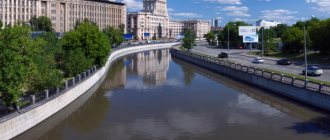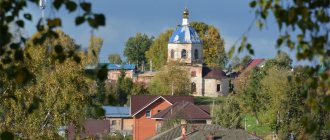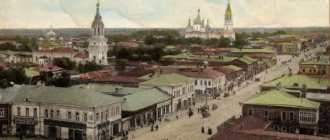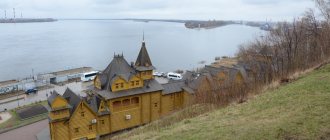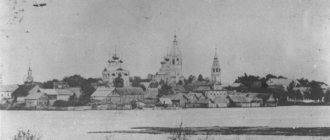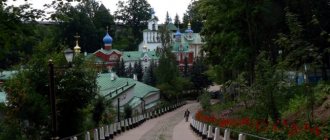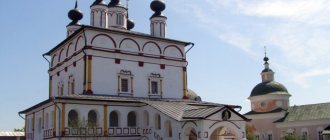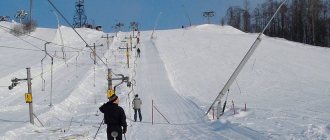There is a legend that Stepan Razin drowned a Persian princess in the Volga just near Kineshma, and this is what gave the city its name. Allegedly, the ataman brought the girl onto the deck, and she suspected something was wrong and asked: “Will you throw me?” But there is a more truthful version: the city got its name from the Finno-Ugric tribes that lived here before the arrival of the Slavs. Translated, it means “dark water.”
Kineshma is the birthplace of famous icon painters who worked on the decoration of the Moscow Kremlin: Pavel Nikitin, Andrei Makarov, Anton Amfilov, Gury Nikitin. Composers Sergei Rachmaninov and Alexander Borodin were inspired by local landscapes. For a long time, Alexander Ostrovsky served as a magistrate in the city, who used local legends when writing “The Snow Maiden”.
The area is famous for its anomalies: ghosts live in the local correctional colony and military unit. And in 2011, the builders of the sanatorium became eyewitnesses of strange phenomena: oak trees in the grove disappeared before their eyes, the earth swallowed stones, and people, as if under hypnosis, jumped from the scaffolding. This is due to the fact that there was a pagan sanctuary here for a long time.
Islands and lakes, ostriches, museums, monasteries - what not to miss when driving through the Ivanovo region.
Churches of Kineshma
Kineshma, whose attractions are many temples throughout the city, has ancient churches, most of which were erected in the central part, in contrast to new ones, which were built everywhere.
Kineshma Kremlin (Church of the Ascension)
The temple was built in 1779 with the money of parishioners. This is a seasonal church made of stone in ancient Slavic forms with a separate bell tower. The apse from the East and the vestibule from the West adjoin the 4-pillar, 2-light, 5-domed temple.
The building was transferred to the local history museum in 1929; in 1935, instead of the bell tower, the Chemical-Technological College was erected. After restoration work, the building almost regained its original appearance. Now the church belongs to the Russian Orthodox Church MP. Location – st. Soviet 45.
Ensemble of the Assumption and Trinity Cathedrals
The ensemble includes the Assumption and Trinity Cathedrals, the priest's dwelling and the bell tower and is located on the site of the former fortress. In 1938, the cathedrals were given over to garages, and in 1945 they were opened again. From 1964 to 1991, an art gallery was located in the Trinity Cathedral. The Assumption Cathedral was built in 1745 with donations from parishioners.
In the same way, in 1838, the Trinity Cathedral was erected according to the plan of a student of the St. Petersburg Royal Academy I. E. Efimov. Both buildings are architectural monuments. Now all the buildings have been transferred to the Russian Orthodox Church. Location: st. Soviet 2.
Annunciation Church
The church was built in 1805 near the city burial site. Initially there was a separately built tower with bells, but in the 2nd half of the 19th century. the buildings were united by a large refectory. The temple is an architectural monument of early classicism with baroque elements. The building has a faceted dome; the tower is distinguished by spacious arched openings with double columns.
The most expensive relic located here was an icon depicting Mikhail Malein.
According to legend, Tsar Mikhail Fedorovich gave it to the church. Another valuable thing is an old fold with a cross. Inside it, according to the inscription, are the remains of saints, grains of the sacred tree and the clothes of the Mother of God. The building belongs to the Russian Orthodox Church. Location – st. Ryleevskaya 9.
Church of the Nativity
The building was built in 1754 and is the winter church of the Assumption parish. This is a single-apse quadrangle, there is a refectory, a pillar-shaped hipped bell tower.
The church was rebuilt and closed in the first half of the 20th century. The bell tower was broken, all the interior decoration was lost, only small fragments of 19th-century painting remained on one wall in the refectory. In 1993, the building was transferred to the Russian Orthodox Church and despite the fact that the building is in disrepair, religious services are regularly held here. Location – st. Yuryevskaya 13.
Church of the Transfiguration
Construction of the church was completed in 1694. This brick, 2-story, 5-domed church with a separate bell tower was built instead of a wooden church. There are 5 altars in total: the upper floor of St. the prophet Elijah, the lower one - St. unmercenaries Damian and Cosmas, icons of the Mother of God and Michael, St. Barbarians.
The construction sponsor is L.D. Tyurin. The temple was closed no later than 1930, the domes and bell tower were broken. The building housed a warehouse. In 2000, the church was transferred to the Russian Orthodox Church and restored. Location – st. Yuryevskaya 16.
Chapel on the Kineshma trade square
The chapel was erected in 1744. A massive crucifix is installed inside. This is an 8-sided brick building with a tent-shaped dome, built on the mass grave of city militiamen who died on May 26, 1609 in a battle with the Poles.
Initially, there was only a wooden cross on the mass grave. For more than 300 years, a memorial service was held here on the day of the death of soldiers, they took the oath, and left for battle from this place. Now the building is owned by the Russian Orthodox Church. Location – st. Vichugskaya 92.
Ensemble of the Assumption and Trinity Cathedrals
It is located on the high bank of the Volga, where it blends extremely organically into the surrounding landscape. The ensemble includes two cathedrals (Assumption and Trinity), a bell tower and a priest's house. All structures were built with funds raised by parishioners. First, the Assumption Cathedral in 1745, then the bell tower (in 1798) - it is five-tiered and to this day is considered one of the most picturesque in the Ivanovo region.
The Trinity Cathedral was built later - in 1838. In 1938, both cathedrals were closed, but reopened in 1945. The entire ensemble is an architectural monument, but both cathedrals are active and currently belong to the Russian Orthodox Church.
Location: Sovetskaya street - 2.
Monuments and sculptures
Kineshma, whose attractions are a combination of new buildings and historical monuments, is famous for its many monuments.
House of notary Gorodetsky
The building, made of 1 floor, made of red brick, is an archaeological site with modernist fragments. The northern facade of the building is finished figuratively and turned towards the Volga.
During the period of Soviet power, the mansion housed a children's clinic; now installation work is being carried out here. Location – st. Soviet 36.
Monument to Commander Fyodor Boborykin
The monument was opened on September 22, 2012 and was built by city residents at their own expense in honor of commander Fyodor Boborykin, who led the militia in 1609. He was one of the first to repel the invaders. The authorship belongs to the sculptor Ravil Yusupov. Location – pl. Revolutions.
Temperance society tea room
The building was erected in the 2nd half of the 19th century. This is one of the non-alcoholic cafes that opened at the Holy Cross and Ascension churches. The usual menu is tea with sweets, jam or sandwiches.
The proceeds went to public needs. In 1917, the headquarters of the revolution , the Council of Working People's Deputies, was located in this place, as written on the memorial plaque installed on the left side of the building. After some time, cafes and shopping boutiques were located here. Nowadays there is a hotel complex in the teahouse.
Episodes from the films “The Ulyanov Family” and “Yakov Sverdlov” were filmed against the backdrop of the building.
Location – Volzhsky Blvd. 1a.
Mansion of the manufacturer Mindovsky
The house was built in the 2nd half of the 19th century. by order of Ivan Mindovsky, a major industrialist for his passion. The building went down in history as the “grain commission”. In 1906, unrest arose in the city, and a strike of the working class was organized due to the rise in prices of grain traders due to a bad harvest. On February 15, 1907, a “grain commission” consisting of 18–25 people moved into the house.
They exercised control over sellers, forcing them to sell bread at the set price, without inflating it. After 2 weeks, the commission was dispersed by Cossacks who arrived from Kostroma.
In 1917, the house housed the Council of Workers' and Soldiers' Deputies, and the headquarters of the Red Guard was also located here. Now the building has been transferred to the Regional Tuberculosis Dispensary. Location – st. Soviet 10.
Monument to Alexander Mikhailovich Vasilevsky
The monument was erected on July 31, 1949 in connection with the order of the Supreme Council of the Soviet Union on the erection of busts of double Heroes of the USSR in their places of birth. The author of the sculpture is E.V. Vutetich.
Alexander Vasilevsky was twice awarded the highest military order, and twice he was awarded the title of Hero of the USSR. Location - crossing of the street. Ostrovsky and st. Lenin.
Monument to Boborykin
The monument was erected in 2012 solely at the expense of funds raised by townspeople and public figures. Fyodor Boborykin is considered an honorary citizen of Kineshma; it was he who led the militia that defended the city from the Polish-Lithuanian invaders during the Time of Troubles.
Location: Revolution Square.
Museums, theaters
The attractions erected in Kineshma at the beginning of the 20th century were made according to the designs of the Moscow office of Julius Burley.
Museum of felt boots
The museum was formed by the Sokolov family and officially opened on June 28, 2012. Now there are more than 150 exhibition items, including outdated wool cutting machines, tools for the production of felt boots, various types of shoes and wool products. The museum also displays the largest pair of felt boots, measuring more than 2 m, and the smallest, measuring 6 mm.
- Location: st. Frunze 6.
- Opening hours: 11:00 – 15:00.
- Closed: Monday.
Sevryugov Estate
The estate was built in 1904 by order of the heirs of the manufacturer P.F. Sevryugov for 2 years. In 1918, the building was nationalized, the eldest son and copyright holder of the estate N.P. Sevryugov rejected the offer of the new government to become a manager and left for France.
In 1930, a factory club was located here, and gradually everything was plundered, the garden was cut down for firewood. In 1971, the building was registered with the state as an architectural monument; in 1986, the estate was transferred to the state protection of the city. Now the estate is in disrepair. Location: st. Socialist 54a.
Tikhomirov's House
The building of 3 floors was erected in the middle of the 19th century. The first owners were the Polenov merchants, who were involved in charity work. In 1890, after a fire, the house was purchased by merchant Ivan Grigorievich Tikhomirov, who restored it.
The 1st floor was turned over to retail boutiques, and people lived on the 2nd and 3rd floors. Now there is an art salon and shops here, the upper floors also remain residential. Location: st. Sovetskaya 1/2.
Kineshma Art and History Museum
The organization of the museum took place in 1919 at the request of the district department of the people's assembly. Here are works of fine art from the collection of N.P. Ruzsky. The museum is also the only organization in the city that deals with inbound tourism.
- Location: st. Frunze 2.
- Opening hours: 9:00 – 17:00.
- Day off: no.
Museum of Military Equipment
The museum was opened in 2013. 14 exhibits are displayed in the open air - samples of military equipment of the 20th century. There is a T-34 tank, a Katyusha artillery mount and armored vehicles from different years. Location: Victory Park.
Drama Theater
On the initiative of the playwright Ostrovsky, who held the positions of justice of the peace and head of the zemstvo assembly for several years, the theater began its work in 1897.
A monument to Ostrovsky was erected near the building. Location: st. Soviet 12.
Kineshma Art and History Museum
It was created on the initiative of the county department of public education in 1919, and was called a scientific and art museum. Today, the museum's exhibitions are located in buildings of three architectural monuments. The local history section is located in the Church of the Ascension of the Lord, the art gallery is in the building of the Mother of God House Church, built in 1908, and in the building of the former House of Contempt of the Poor (built in 1866).
Location: Komsomolskaya street - 30.
Bridges
The examination found that one of the city’s bridges, Kineshemsky, can dance and sway just like the Volgograd Bridge in 2010.
Kineshma Bridge
The bridge was erected in 2003, and it is considered one of the longest in Russia. Its length is 1.63 km. The bridge connects to the Kostroma-Kirov line in the Kostroma region. The attraction was opened by a representative of the State. Duma of the Russian Federation by B. Gryzlov.
- Location: Kineshma-Zavolzhsk road.
- Coordinates: 57.492466, 42.073765.
Nikolsky Bridge
The bridge crosses the river. Kineshemka and connects the residential areas of Logovoye, Sokolniki, Tomna and Zalesye with the main part of the city. The metal structure was built on the model of the European Eiffel bridges of the late 19th century.
The building got its name from the St. Nicholas Church, which is located nearby, but has not survived to this day.
- Location: between Ivanovskaya street and st. Yurievetskaya.
- Coordinates: 57.441353, 42.177590
Kuznetsky Bridge
The bridge is the border of the Volga's navigable space and has been in poor condition since the 60s. It connects the city center with the residential area of Sokolniki and is capable of carrying heavier traffic than the Nikolsky Bridge. Coordinates: 57°26'24″N 42°9'15″E
Drama Theater named after A.N. Ostrovsky
It is rightfully considered one of the oldest provincial theaters in Russia. It was founded in 1896 in the city of Kineshma, Kostroma province. Since its foundation, the theater has been named after A. N. Ostrovsky, and was created with the direct participation of members of the playwright’s family.
It was not by chance that the theater received the Ostrovsky name. His estate, Shchelykovo, was located on the territory of the Kineshma district, and the playwright spent several months a year there, taking an active part in the life of the district. The first performance played on the theater stage was based on Ostrovsky's play “Poverty is not a vice.” The premiere took place on December 26, 1897.
Location: Sovetskaya street - 12.
Cinema "Passage"
The cinema was built at the beginning of the twentieth century. with money from the merchant Tikhomirov and called itself “Modern”. This is a rectangular elongated house, two-level. The main facade of the building, looking at the street. Ryleevskaya, decoratively decorated.
Next to the cash register there is a dressing room, then a hall located on another level. Initially, retail space was located in the lobby, and a restaurant was located on the ground floor. In 1920, the cinema was nationalized and turned into a warehouse.
Most of the interior decorations were also destroyed. Now there is a cultural and entertainment center here. Location: st. Ryleevskaya 4.
Red and White shopping arcades
The houses were built in the 19th – early 20th centuries. Red rows are so called because of the color of the bricks. The style is eclectic, with some modernist inclusions and Romanesque decor. Inside, the building is divided into retail spaces with individual entrances. Today there are shops here.
The White Rows were demolished in the mid-twentieth century. Previously they stood in front of the Reds, but now the Molodezhny square is located here. At the end of the twentieth century. the house has been partially restored. Location: st. Ryleevskaya 1.
Sanatorium named after Stanko
The sanatorium offers a variety of healing and treatment procedures, for example, “beautiful figure”, “healthy child”, “cleansing the body” and so on. The highly qualified staff of the hospital can prepare an individual program for everyone. In summer, the resort has a beach, water attractions, and you can also play tennis. In winter, here you can go tubing, ice fishing, ice skating or skiing, and play laser tag.
Volzhsky Boulevard
Kineshma (attractions exist in every district of the city) offers tourists many places for recreation and walks. Volzhskaya Alley is lined with paving stones and is located above a large cliff, with a river flowing at the foot. From here there is a good view of Kineshma, and a road bridge is visible in the distance.
In the 17th century this place was the northern part of the Kineshma fortress. Until 1920, all fences, roads and sheds were made of wood. Along the alley there are civilian buildings; in ancient times, the Church of the Transfiguration of Spasovo stood here, destroyed in 1609. Coordinates: 57.445820, 42.166437
Beautiful places in Kineshma - photos
Volzhsky Boulevard
He is rightfully considered the most beautiful. Locals and visitors love to relax here, especially in the summer and in good weather throughout the year. Many famous figures of science and art once walked along Volzhsky Boulevard.
Until the seventeenth century, the boulevard line represented the northern boundary of the city fortification. At that time, the Church of the Transfiguration of the Savior was located here; it was burned by Polish-Lithuanian invaders at the beginning of the 17th century. Until the beginning of the 20th century, the boulevard was wooden. Later, the paths were paved here and a cast iron fence was installed.
The first civil structures made of stone are located here. This is the house of the Nobility, the local government, a mansion belonging to the manufacturer Mindovsky and others.
Recently, the Boy and the Fish fountain and the Lower Embankment were restored. Today this place is a center for cultural leisure. Holidays, theatrical performances, fairs, and competitions are held here. The most striking event taking place here is called the Volzhsky Boulevard Festival.
Monument to Fyodor Boborykin
Bobrykin was a Russian commander and an honorary citizen of the city. Under his command was the local militia during the Time of Troubles. Historians claim that under the leadership of Bobrykin, the people’s militia was for the first time able to withstand the onslaught of impostors.
The memorial structure was opened in September 2012 in honor of the 400th anniversary of the liberation of the capital by the people's militia. Local residents raised money for production.
Art Gallery
Located in an old charity house for the poor with the Church of the Blessed Virgin Mary. The building is an architectural monument of the 19th century. The first floor is the Exhibition Hall, which houses works by contemporary masters: paintings, sculptures, installations. The “Art of the 20th Century” hall displays the works of artists who connected their work with Kineshma.
The gallery features works by many artists:
- I. Aivazovsky;
- K. Korovin;
- K. Savitsky;
- L. Turzhansky;
- V. Bychkov;
- L. Chernov - Plessky;
- M. Malyutin.
Works by I. Aivazovsky “Trebizond. 1884" and K. Korovin's "Sevastopol" were restored with donations from guests. Location: st. Bolshaya Komsomolskaya 30.
Exhibition “Kineshma felt boots”
Here are felt boots of different sizes, listed in the Russian book of records. You can also get acquainted with the step-by-step technology of their manufacture. The entire exhibition occupies 3 rooms; you can order a guided tour.
Kineshmansky felt boots - a landmark known throughout Russia
- Location: st. Frunze 6.
- Opening hours: 10:00-16:00.
- Closed: Monday.
Other attractions of Kineshma
Museum of felt boots
This interesting exhibition was opened in 2012. The idea of creation belongs to the Sokolov family, who have been making these ancient Russian shoes for 20 years. First, the head of the family made decorative felt boots for his daughters, then he created a pair of shoes that were included in the Russian Book of Records.
This is interesting: the hands of an extraordinary craftsman created the smallest felt boots, with a foot length of six millimeters. His creation is also a “monster” felt boot, two meters high. This family does not stop doing what they love, and their creations have already won many prizes at national and international competitions.
In the museum, which is located on the street. Frunze, 6, you can see more than 200 interesting types of felt boots. In addition to them, other wool products are exhibited here. For example, the attention of many visitors is attracted by chess pieces made of wool, decorated with sequins and beads.
Kineshma Bridge
This is a four-lane bridge connection between Kineshma and the Kostroma region and the road to Kirov. Its length is 1646 m, which is quite a lot by our standards. Pedestrians are not allowed to move here.
The project began to be developed in 1976. And at first it was planned to build a two-tier structure. Cars were supposed to move in the top row, and trains were supposed to pass in the bottom row. Construction began in 1984, but after 12 years, funding for the construction was stopped.
According to the new project, the bridge was completed in 2003, and now guests can admire not only the embankment.
Nikolsky Bridge
In ancient times, the central district of the city and Zarechye were connected by a wooden bridge. In the middle of the 20th century, a new bridge was built; it turned out to be a steel arched structure. She is considered unique. In fact, there is no other similar openwork semi-ring anywhere.
The bridge got its name from the street of the same name, located near the Resurrection Church, which has a St. Nicholas chapel. Now in its place there is a square and a fountain.
Restaurant-museum "Russian Izba"
This restaurant and hotel complex provides an excellent opportunity to escape from the bustle of the city.
Here guests will find interesting entertainment events and programs. At the main entrance, visitors are greeted by a teahouse-museum, the design of which completely recreates the atmosphere of peasant life at the end of the 19th century. A summer veranda has been built near the main building, from which an amazing view of the Volga opens.
On the second floor they made a hotel with a viewing platform. It offers a wonderful panorama of the river expanses. This cozy and beautiful place is deservedly popular among locals and tourists.
The ancient Russian city of Kineshma is an excellent place to relax. The area is rich in historical events and cultural potential. These places also attract with the indescribable beauty of the picturesque expanses of the Volga, the grandeur of the temples, and neat well-groomed streets. A holiday here is an excellent opportunity to escape from everyday worries and visit the end of the 19th century.
We bring to your attention a video about the city of Kineshma and its attractions, and under the video there are photographs with interesting views of the city.
Where to eat
Of all the establishments in the city, the following stand out:
- Coffee shop on Malaya Pokrovskaya. Located on the street. Lenina, 22.
- Cafe Coffee shop Caramel. Located on the street. Lenina, 55.
- Restaurant Russian Izba. Location – Volzhsky Blvd., 2.
- Pivgrad. Address: st. Gogol, 2/67.
- Peaceful Pier. Located on the river on Volzhsky Boulevard.
- Cafe Pyramid. Located on the street. them. M. Gorky, 25.
- Restaurant Volzhskie Zori. Located on Volzhsky Boulevard.
- Cafe Yamato. Address: st. Maxim Gorky, 19.
According to numerous reviews from visitors to the Venice pizzeria, it is not recommended to dine here, as the prices are inflated and do not correspond to the quality.
Where to stay
There are 3 main hotels in the city:
- Sadko Hotel. There is a bar, free WI-Fi, 24-hour reception, and a restaurant. The cost of breakfast is 120 rubles, lunch is 200 rubles, dinner is 150 rubles. The average cost of accommodation for 1 person per day is 1200 rubles. Address: st. Shchorsa 1a.
- Peaceful Pier. The hotel is located in a house on the water, 5 min. Walking distance from the city center. Type of breakfast - continental, buffet. There is private parking and a bar. The average daily cost for 1 adult is 2,700 rubles.
- Volga. The hotel is located on the outskirts of the city. There is a fitness center, restaurant, and free Wi-Fi. Cost per day – 900 rubles.
No less popular is the option of renting an apartment, especially if the trip is planned by a group of people:
- Apartment on the street Red Metalist 31. Total area 60 m2, accommodates up to 6 people. Pets are allowed. Cost per day – 3500 rubles.
- Santa Barbara. Address: st. Kasimikhenskaya 1. Pets are allowed. Price per day – 700 rub.
- Apartment on the street Sports 2 . The total area is 36 m2, the number of guests is 2. There is a kitchen and free Wi-Fi. Cost per day – 1500 rubles.
Kineshma - Yuryevets: Out of decline with hope for revival
Constantinople observer Andrei Malosolov continues his journey through the Ivanovo region, one of the poorest in European Russia, and at the same time one of the richest in historical settlements and beautiful architectural monuments
This time I left the anchor point of my trip, the town of Ples, reminiscent of Nice in miniature, and drove along a large day route: Kineshma - the village of Elnat - Yuryevets. Both towns and the village are historical settlements. The most beautiful views from the banks of the Volga, cultural and historical monuments are interspersed with the unsightly legacy of the Soviet attitude towards Russian history and the apocalypse of the 90s, which turned not only the Ivanovo region, but the entire country into dust and horror.
But the madness of Yeltsinism cost the Ivanovo region the most - the region almost entirely served such an industry as weaving, and in the 90s Russia completely switched to Turkish and Chinese clothes and fabrics. The region found itself completely excluded from economic processes and is only now slowly coming to its senses. In order to fully recover, it will take many more years, a change in the mentality of the population, and its working hands. And, of course, demographics. The region lost a lot in population in the 90s and early 2000s. Many people left for Moscow, Nizhny Novgorod and Ivanovo out of hopelessness. Many work on a rotational basis in the capital, earning their living by working as security guards in supermarkets and construction sites.
Kineshma
Kineshma is also a post-apocalyptic territory, like Yuzha, Dunilovo, Shuya, and Ivanovo itself. It is the second largest city in the region, with more than 80 thousand residents. From the Kineshma embankment there are breathtaking views of the blue expanse of the Volga. The city has been known since the 1400s, but is actually believed by locals to be a century older. In 1429, the city was completely destroyed by the Tatars. Many residents of Kineshma died.
View of Kineshma from the Volga. Photo: Andrey Malosolov
During the Time of Troubles, the local militia, led by governor Fyodor Boborykin, to whom a monument was erected in the very center of Kineshma, took part in battles against the Polish occupiers. On the territory of the modern city, three major battles took place with the detachments of Lisovsky and Tyshkevich and the Russian traitors from Moscow who joined them. The militia was defeated twice, Boborykin died as a result, and Kineshma was completely destroyed in one battle. At all. To the root...
Monument to Fyodor Boborykin. Photo: Andrey Malosolov
During the second battle with the Poles, part of the population, including women and children, took refuge in a wooden church on the banks of the Volga. By order of Lisovsky, the church was burned along with everyone who tried to escape in it, and this is worth remembering by everyone who wants to repent and pay the Poles insulted and humiliated by the Russians.
When a militia detachment led by Minin and Pozharsky was formed in Nizhny Novgorod, the militia’s route to Moscow passed through Kineshma, which was devastated and burned to the ground. The Kineshma residents who survived made a significant contribution to the militia in manpower, money and provisions. Local residents also helped the militia get to Kostroma along the flooded rivers at that time.
(Left to right) Mikhail Zharov, Alexey Ukhalov and Andrey Malosolov. Photo: Andrey Malosolov
In Kineshma, I was met by local journalists - Mikhail Zharov and Alexey Ukhalov. They found out through the social network VKontakte about my trip to their place and gladly volunteered to help with the excursion.
Journalism in Kineshma is in the same decline as the economy: On the day of my arrival, Mikhail handed over the issue to the press, he was the last reporter writing in the editorial office. That’s why I spent little time. Mikhail is not only a journalist, but also an active local historian.
Kineshma street. Photo: Andrey Malosolov
He unearthed a story about how Marshal Alexander Vasilevsky, a native of Vichuga, neighboring Kineshma, organized a military operation here in 1946 to eliminate a gang of war deserters who were plundering Kineshma and Kostroma. Two thousand people were captured or killed during the operation. Zharov managed to find out that one of the creators of the first Soviet atomic bomb was a Kineshman. I was simply blown away by the journalist’s story about the family of Roman Schmidt from Shuya, which had 15 children!
That's another thing. When I released this material, wise people remembered that the Ivanovo region has always been famous for large families,” said Mikhail. “And the peasant Fyodor Vasiliev from the village of Vasilievsky, Shuisky district, who lived in the 18th-19th centuries, gave birth to a total of 87 children, 69 from his first wife and 18 from his second.”
Kineshma embankment. Photo: Andrey Malosolov
Alexey Ukhalov shows me Kineshma. He is a photographer for a publication, but he doesn’t have enough money, so he earns money by photographing weddings and celebrations. “This filming is already driving me crazy,” admits Alexey, especially considering how often weddings take place in the provinces. Alexey is thinking about working in Moscow, but loves his city very much. He is one of those who reasonably evaluates the so-called Varangians among local authorities.
“Muscovites bring investments to the regions, build hotels and businesses, I am not against them. In addition, they help bring tourist flows to Kineshma,”
- says Ukhalov.
Restaurant in Kineshma. Photo: Andrey Malosolov
At the same time, it also notes its own, local investors. On the Volga embankment we had lunch at a wonderful Russian restaurant, which is run by a Kineshma businessman. The menu includes dishes of Russian cuisine, and there is a specialty - Kineshma deep-fried pie with broth, which for some reason is also called inside-out soup. On the embankment there is not only this restaurant with prices that are ridiculous by Moscow standards, but also an excellent hotel in the Russian merchant style.
A little further there is a very good tourist complex - houses and landing stages with rooms, cafes, snack bars. The embankment itself has been restored and offers excellent views of the Volga. Tourists willingly travel to Kineshma along routes from Kostroma, Moscow and Yaroslavl, mainly by river transport.
Cathedral in Kineshma. Photo: Andrey Malosolov
Alexey shows the embankment, beautiful and convenient. Ancient houses are gradually being restored, and in this matter Ukhalov hopes for the active participation of the new and. O. Governor Stanislav Voskresensky. He is going to make a second or third Ples from Kineshma and neighboring Yuryevets.
I think that tourism will help us survive, because although the industry is recovering, a lot of things were, of course, lost in the 90s,”
- Alexey emphasizes.
I’m leaving Kineshma just for Yuryevets. I make a detour to cross the Volga on the second bridge. The main bridge of Kineshma has been under repair for ages. Along the way I see both poor houses and the richest mansions. There are expensive and beautiful yachts in the backwater. There is enough of everything here, both good and bad. But I discover that the stories about the absolutely terrifying poverty of the region are greatly exaggerated by various Moscow snobs.
Fuck
Temple in Yolnati. Photo: Andrey Malosolov
One of the best roads I have ever seen leads to Yuryevets - Ukhalov’s words about Voskresensky are coming true. I spent most of my trip around the Ivanovo region as if I had been jumping on a crazy stool for a long time. But here there are no complaints about the quality of the road. On the way we stopped in the historical village of Yolnat. This is another discovery on my journey through the Ivanovo region. Alas, practically nothing remains of the old glorious and rich village that arose in the 13th century.
Priest's house in Yolnati. Photo: Andrey Malosolov
Except for the ancient temple and the most beautiful views of the river. The rector of the temple, Father Maxim, holds the village in his fist. He admonishes local men, restored a 19th-century temple, runs a large farm, and his wife, an artist, paints local houses and a temple. The village has good quality village houses and large farms. The slogan “There is no life after the Moscow Ring Road” does not work here.
Yuryevets
But Yuryevets truly destroyed me. Devastated. Upset. Killed...
The city, founded in 1225 (according to the historian Tatishchev - a century earlier) without exaggeration turned out to be the most interesting and cool city of my trip to the Ivanovo region. This is a brilliantly beautiful town, which, if all historical buildings are completely restored, will be the second Plyos, the third Suzdal. The tourism potential of Yuryevets has great prospects - it is a beautiful ancient city, terraced down to the Volga from high hills.
Yuryevets. Photo: Andrey Malosolov
Only its current state is so depressing that for the first time during my entire trip through the already poor Ivanovo region I left this wonderful Volga city completely depressed. To bring to such a state a city with a military history, where significant Russian princes were born and raised, the conqueror of Siberia Ermak, Archpriest Avvakum, Andrei Tarkovsky, generals and great designers, architects the Vesnin brothers - it was necessary to make a special effort.
Yuryevets is another story of a disaster that befell the Ivanovo province in the post-Soviet period. The city is very loved by tourists, but after the main light industry enterprises there closed, both it and its residents degraded.
Central street Yuryevets. Photo: Andrey Malosolov
The city is divided into several districts based on prosperity. The street leading to the 16th-century Epiphany Church, as well as to the Andrei Tarkovsky Museum, is tiled, equipped with lanterns, and there are neat houses, well-groomed and attractive. Sovetskaya Street (formerly Georgievskaya) is the central street of the city, it looks as if it had been methodically smoothed over by attack aircraft for several years. The condition of the houses of the 17th-19th centuries causes shock and horror. Only the Gorokhov House and one of the temples are in decent condition. And this is because the Gorokhov House of the first half of the 19th century houses a police department, and in the Ivanovo region they require government agencies to keep their buildings in good condition.
Tarkovsky Museum in Yuryevets. Photo: Andrey Malosolov
Everything else is darkness and decay, dust and nightmare! Some shabby shops with ugly interiors, a creepy cafe "Royal", named, apparently, in honor of alcohol from the 90s...
The Volga embankment, which offers stunning views of the great Russian river, is not even in a terrible state - it simply does not exist, everything here is littered with some kind of blocks, beams and rubbish. What can we talk about if the city's dominant features - the Assumption and the Entrance of Jerusalem Cathedral with a five-tiered giant bell tower - are in a depressing state... Looking at this beauty, walled up in a marginal temporary hole, you inevitably fall into melancholy.
Yuryevets embankment. Photo: Andrey Malosolov
As always, I find a conversation partner in the most unexpected place - in a car wash at the entrance to the city. The workers, a married couple, talk sadly about their hometown. “The locals either go to Moscow to work or drink heavily,” says the washer. He refused to be photographed, but talked about the city. It is ancient and was once very prosperous. Festivals are held here in memory of Tarkovsky. Now the beautiful town looks poor. It does not have a gas pipeline: Gazprom once installed several of its substations for show for some elections, and removed them after the elections. “We heat our car wash with wood. Is this normal? - asks the washer.
“In the summer, everyone here prays for tourists who leave money in Yuryevets. In winter, there is mortal melancholy here, we are probably alone and work for the whole of Yuryevets,” continues the washer’s wife.
Yuryevets. Photo: Andrey Malosolov
Yuryevets is the oldest city in the Ivanovo region. It was founded by Prince Yuri II of Vladimir on the site of the appearance of the icon of the Great Martyr George the Victorious to him and was named after this saint - Yuriev-Povolsky. In 1237 it was destroyed by Batu's army. Founded to protect central and northern Rus' from attacks from the east, it later developed into an important trading hub.
In January 1609, a local militia led by the charmer Fyodor the Red set out from Yuryevets against the Polish-Lithuanian invaders. In 1620, the Epiphany Church was built in the city, in 1700 - the Annunciation Church, in 1746 - the Transfiguration Church. The archpriest in Yuryevets in 1651 was Avvakum, the future leader of the Old Believers. After he arrived in this city, where he mercilessly persecuted any deviation from church rules, already eight weeks later “the priests and women, whom he had dissuaded from fornication, beat him with a batog in the middle of the street and trampled him and threatened to completely kill the thief, whore son, yes and throw the body into the ditch for the dogs.”
Yuryevets. Photo: Andrey Malosolov
In 1820, a Parish school was opened in the city, in 1871 - the Yuryevets flax factory, which provided people with work until the end of the 90s; in 1876 the Yuryevets regional library was founded. In Yuryevets they took care of the poor: in 1889, a charity home for poor citizens was opened. In 1899, the women's “Progymnasium named after A. S. Pushkin” was opened. In 1906, a starch factory was built in Yuryevets.
Before the revolution, it was a beautiful and prosperous city, which did not stop its residents from willingly accepting Soviet power in 1918.
Yuryevets. Photo: Andrey Malosolov
However, there is good news from Yuryevets. Current and. O. Governor Voskresensky, by the way, a Muscovite, is going to make a new Plyos out of the city, and intends to attract large investments here. An excellent road has already been built from Kineshma here, and in some places the city has been patched up, although there is still a long way to go. This is really good news, and in Yuryevets itself there is great hope for Voskresensky.
It seems to me that if the future governor manages to revive the city with a great history, then it will become another tourist pearl of the Ivanovo region. If only all this really happened!
Well, in the next chapter I will talk not about Ivanovo poverty, but about wealth and prosperity in this region.
What to bring from Kineshma as a gift
Souvenirs in the museum of felt boots for every taste, size, age and budget, original felt felt products.
| What to buy | Where to buy | Opening hours |
| Valenki-souvenirs (from 100 rub.) | Museum of felt boots St. Frunze 6 | 10:00-16:00 Tue — Sun. |
| Decorative items of applied art (from 250 rub.) | Art Club St. Soviet 1/2. | 10:00-18:00. |
| Products of folk specialists, paintings. | Club in the Kineshma Art and Historical Museum St. Komsomolskaya 30. | 09:00-17:30 Tue. – Fri. 11:00 – 17:30 Sat. — Sun. 4th Friday – sanitary day. |
| Artistic portrait to order | Private gallery of artist Evgeniy Trofimov St. them. Lenina 27 | 9:00-17:00 Mon. – Fri. 9:00-13:00 Sat. |
According to legend, there is another interesting attraction in Kineshma - an underground city with a railway. There is evidence that during the war, important things were brought here through secret routes for storage.
Author: Sadovskaya Alena
Article design: Mila Friedan
Architectural sights of Kineshma
Red and White shopping arcades
Location: the center of Kineshma. They make up an entire shopping complex. The local merchants allocated funds for its construction.
This old building is located in the central part of the city. Both buildings were erected at the turn of the 19th and 20th centuries. The red rows are made of red brick in an eclectic manner; no cladding was used. The structure is decorated with Art Nouveau details and Romanesque decor.
The interior spaces are divided into trading rooms, each of which has access to the street. There are shops in the Red Rows, but the White Rows have not yet been restored.
Kunsthistorisches Museum
This establishment is the second oldest in the Ivanovo region. The date of its foundation is 1919. The basis of the museum’s funds are objects of painting, graphics and decorative and applied art. In addition, there are exhibits representing furniture craftsmanship. They were given to N.P. Ruzsky, a hereditary nobleman, philanthropist and aristocrat of spirit.
The museum's collection is regularly replenished with items that have historical value for the region.
The museum has an art salon where you can buy works of local painters, creations of folk craftsmen and various souvenirs.
